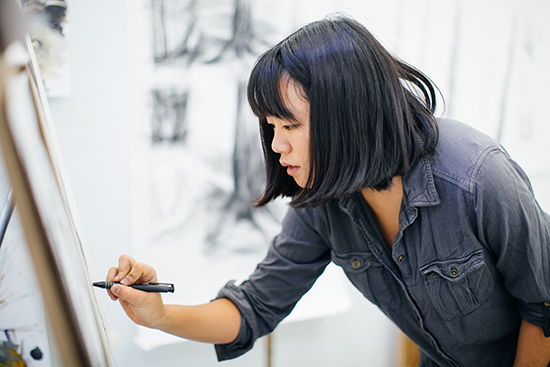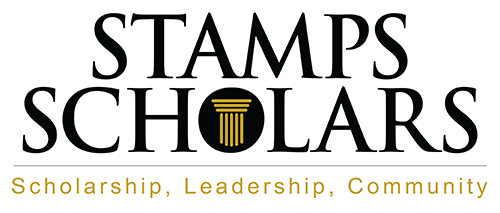Where Art and Science Meet
By Hannah Steinkopf-Frank
 Dartmouth College alumna Amy Yun Zhang is continuing her Stamps-funded project exploring connections between biology and visual art.
Dartmouth College alumna Amy Yun Zhang is continuing her Stamps-funded project exploring connections between biology and visual art.
Zhang grew up in New Jersey and enjoyed drawing, nature documentaries, and exploring the creeks behind her childhood apartment. A memorable experience was traveling to Peru after eighth grade to learn about sustainability in the Amazon, which inspired her interest in conservation.
“As a child, I romanticized early naturalists: The explorer/biologist/artist who would make detailed sketches and categorize, observe, and document. Later on, science and art became two different ways of exploring the world, of being curious about things. For me, they come together very naturally.”
She was also editor of the school’s literary magazine and took part in the Columbia Science Honors program, in which high school students learn from professors and graduate students at the university.
Her freshman year at Dartmouth, she became involved with the Women in Science Project. She explored the effect of land use on insect emergence in neotropical streams.
“It was mostly sitting in a lab and identifying smushed insects in sticky traps under a microscope.”
During her second year, she took part in the sophomore science program, analyzing videos of big brown bats to try to understand the evolutionary function of distress calls.
“When you catch certain types of bats, they emit a distress call that other bats will respond to. So the question is, if the distress call indicates danger, why would other bats approach? Is it altruism, information gathering, or something else?”
She helped set up an experiment in which bats were played different sounds, including distress calls, and their flight patterns were recorded.
She also joined the DALI Lab, a leadership and innovation lab that pairs designers and developers to collaborate on solutions for partners’ projects. The interdisciplinary workspace matched Zhang’s interests. She worked there for the rest of her time at Dartmouth as a UI/UX designer and as a student staff member, supervising and mentoring other projects.
“I liked that students had a lot of say in how the lab was run and being able to take a wider, more conceptual view of the projects. I enjoy thinking about user experience: How do you direct the flow of people’s attention through these different screens?”
Her projects included designing a new website for the school newspaper and developing a prototype software for tracking sexual assault evidence collection kits, as across the country, only a small percentage are processed and used as evidence.
While she was taking part in a biology foreign study program in Costa Rico and Little Cayman, fellow Scholar Leehi Yona told her about the Stamps Scholarship, which at Dartmouth, provides enrichment funds for an independent project.
“The trip was fantastic, exhausting, and amazing. One thing I loved about the Stamps program was how flexible it was. I applied with this essential question of how are the arts and sciences related: What is the function of art and science in society, and how can art and science collaborate together?”
She began by talking to professors across disciplines to learn about their experiences exploring the intersection of art and science. A professor invited her to a data visualization and sonification workshop at Hubbard Brook Experimental Forest.
She also worked with a professor in evolutionary computational genomics to create charcoal portraits of the stages of assembly of gene transfer agents (GTAs). As existing images of GTAs are grainy, there is room for creative expression.
The question was, “How does having an artist interpret data make it more than purely informational?”
The summer after her junior year, she interned with the Smithsonian Tropical Research Institute in Gamboa, Panama. The project took an evolutionary perspective on sleep and learning in fruit bats and honeybees.
Her junior year, she created a poster and gave part of the keynote for a campus conference called “Changing Climate, Changing Minds.”
She said it was “awesome talking about using art as a way to get people to have an emotional connection to information and as a way to understand our evolutionary history and psychology to create societal action.”
Her senior year, she delved into a project building a 3D model that animated the gait of a human ancestor. She said completing the almost two-year feat, which was a collaboration with an anthropology professor, was “pretty exciting.”
This past summer, she took part in an animation program in Paris, as she is interested in “animation and narrative as forms of storytelling and communication.”
Although a nerve injury slowed her artistic process, she has begun drawing again and is taking part in a project at the Vermont Institute of Natural Science, a wildlife bird rehabilitation center. She also wants to make an animated short to better understand the process of storytelling, including design, characters, directing, and animation.
Currently, she is working with fellow Dartmouth Stamps Scholar Dondei Dean as a studio art intern. Going forward, she is interested in art residencies around the world and in continuing her studies in biology. Her goal is to use her degrees to promote interdisciplinary literacy and improve her credibility as a storyteller.
“In science, it’s not enough to sit down, do your research, and churn out numbers. You have to tell a story if you want your research to go anywhere. Scientists and artists have this same goal: searching for an answer to some question about the world. In my experience, good artists and good scientists end up being very similar.”
